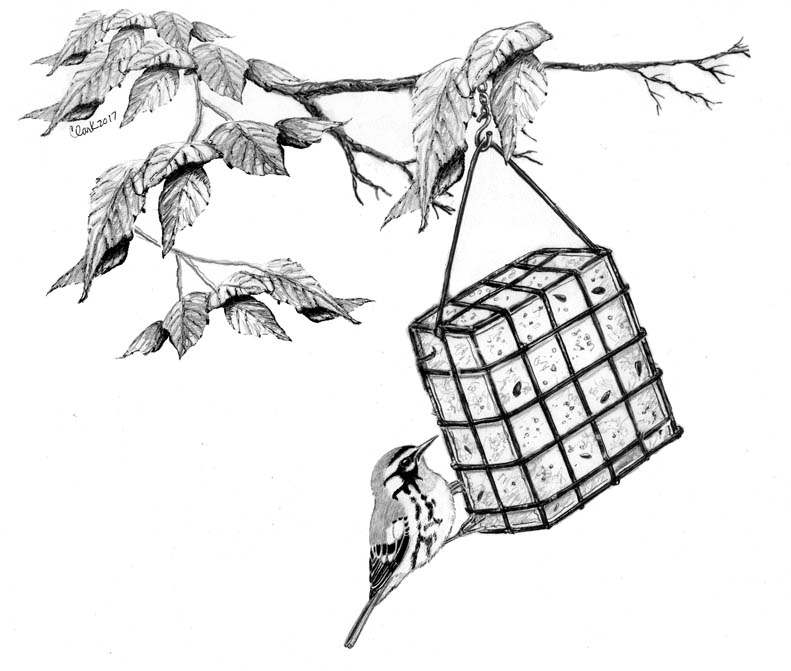
A rare visitor:
Yesterday afternoon I was at Barnstable’s Long Pasture Sanctuary watching a flock of Cedar Waxwings, when I received a text from Casey’s friend, Hannah. She and Casey had just seen a Yellow-throated Warbler. Yellow-throated Warblers are rare on Cape Cod, so I immediately wrote back asking where. She said it was on Casey’s suet feeder. Casey’s suet feeder! That means the warbler is in my yard. I quickly ditched the waxwings and headed home. Unfortunately, by the time I arrived it was dark (stupid clock change). Nuts! I had spent my entire day hiking all over Long Pasture, while Casey sat home, nice and warm, and had a rare bird come to him. Maybe these stay-at-home Millennials are on to something.
Before I begin, I have a complaint about the Yellow-throated Warbler; its name is too long. I would much rather write a column about a bird with a shorter name like, say, a Mallard, which only has seven letters. This darn bird has twenty-one letters in its name, and twenty-two if I pluralize it. That’s way too much extra typing. Then there is the annoying hyphen, which my stubby fingers can never seem to find on the first try. Although, I have to give the bird credit: “Yellow-throated” describes it perfectly. Basically, this tiny bird is gray, black and white, with the brightest yellow throat of any bird in the bird world. Even goldfinches look dull by comparison. Really.
Warblers typically spend their day on the tops of trees searching the leaves for insects, but Yellow-throated Warblers do things differently. They feed by crawling along branches and tree trunks, digging into bark crevices with their long beaks, acting more like nuthatches – nuthatches that are wearing bright yellow bibs. It’s important to note that Yellow-throated Warblers aren’t rare. In fact, their population is doing quite well. But the bulk of them breed in the Southeast U.S. and only occasionally will one venture as far north as New England…or in this case, all the way to Casey’s suet feeder.
The arrival of the Yellow-throated Warbler also coincided with the season’s first blast of cold weather, and that was bad for both the bird and me. I spent the next day standing outside in the frigid wind, staring at a feeder. (I could have also watched from inside Casey’s bedroom, but since I’m overdue for a tetanus shot, it was better I avoided going in there.) During the course of the day I saw chickadees, titmice, assorted woodpeckers and a few snowflakes, but no sign of the warbler. When I finally went inside to warm up, I discovered several messages from other birders who also wanted to see this warbler. I had to tell them that the bird was a no-show and things didn’t look good, and I was bummed. In light of the Scissor-tailed Flycatcher that I missed seeing in Truro a few weeks ago, I was starting to feel jinxed. The birding gods were mad at me for some reason.
The next morning I was back out there, but this would be a brief vigil. It was Saturday and I actually had to go to work. (What’s up with that?) Once again there was no sign of the warbler and it was getting late (9:17AM comes early sometimes). Begrudgingly, I went inside, gathered my stuff for work and was just opening the back door when…zip, the little bird landed on the railing a few feet in front of me. Yay! The birding gods didn’t hate me after all. Like a maniac I started yelling for the rest of the family, grabbed my camera and darted back outside. (My shop would be opening late today.)
In addition to its glowing yellow throat, what impressed me most about the tiny bird was how tame it was. It didn’t care what I did or how close I came; it just continued hunting for insects on the porch. And when it got tired of the porch, it flew up to the roof and started gleaning bugs from underneath our solar panels. (Yet, another reason to go solar.) After taking a ton of photos, I contacted the other birders and told them the bird was back. I then suggested to my wife that she might want to bake some cookies because company was coming. Some spouses may have been annoyed at the thought of strangers arriving on short notice, but my wife headed right for the mixing bowls and said, “I’m on it,” with the usual smile on her face.
Why was this southern bird here, especially this time of year? Why didn’t it head to the tropics with the other warblers? It’s hard to know for sure why a bird migrates in the wrong direction. It could be a genetic defect, or it had become caught in a storm or it simply read the map upside-down, and who hasn’t done that? Will it succumb to the cold? It probably won’t, at least not for a while. Yellow-throated Warblers are tougher than they look and are one of the first warblers to head north in the spring. It should be able to handle a few cold Cape Cod nights, especially if it finds enough suet or insect-filled solar panels to keep it going.
When I finally arrived at work, I showed everyone my photos of the warbler. Some customers were seriously excited, while others just pretended to be interested. (If it’s not a cardinal, they don’t care.) Later in the day I heard from the birders who had stopped at my house. They were all thrilled that they had seen the Yellow-throated Warbler, but what they were most grateful for was my wife’s cookies. I can’t argue with that.